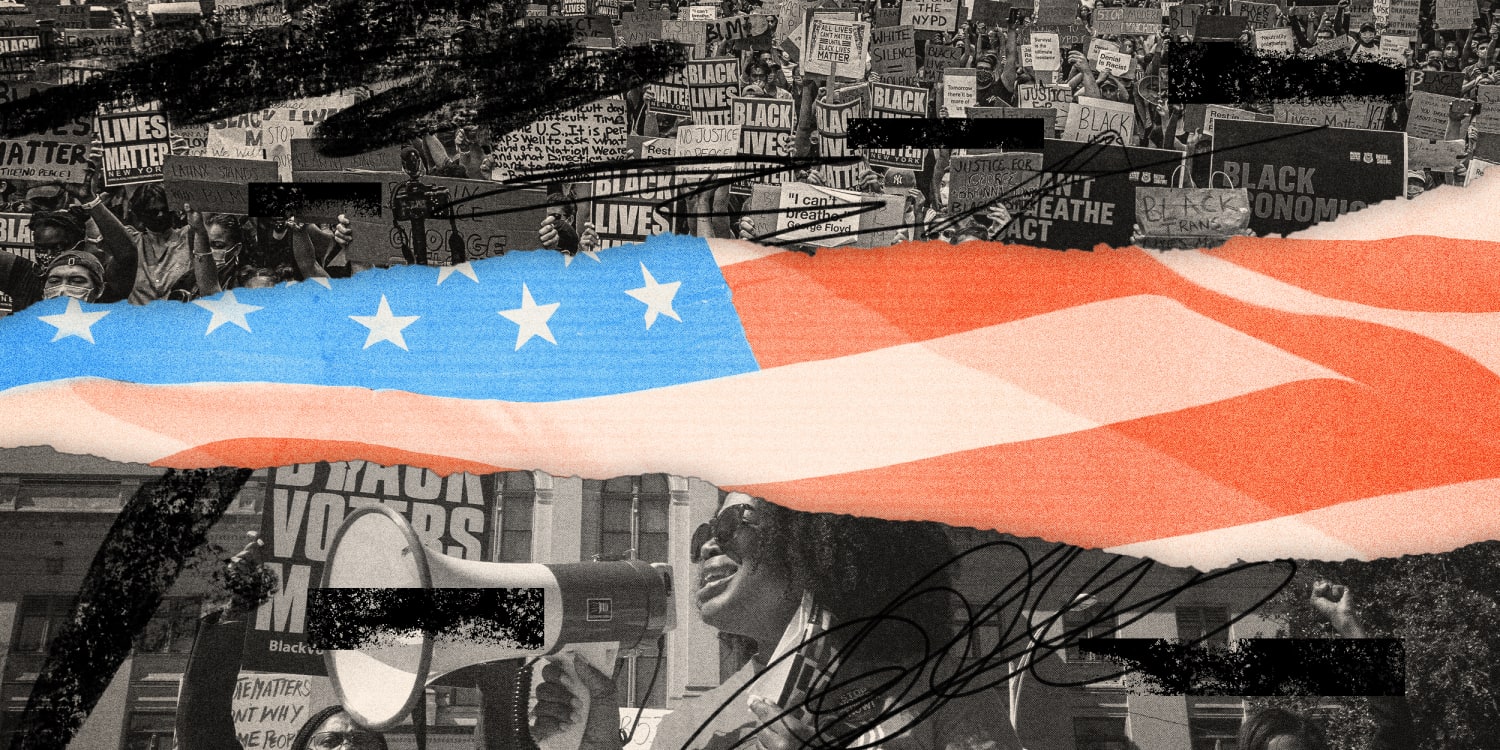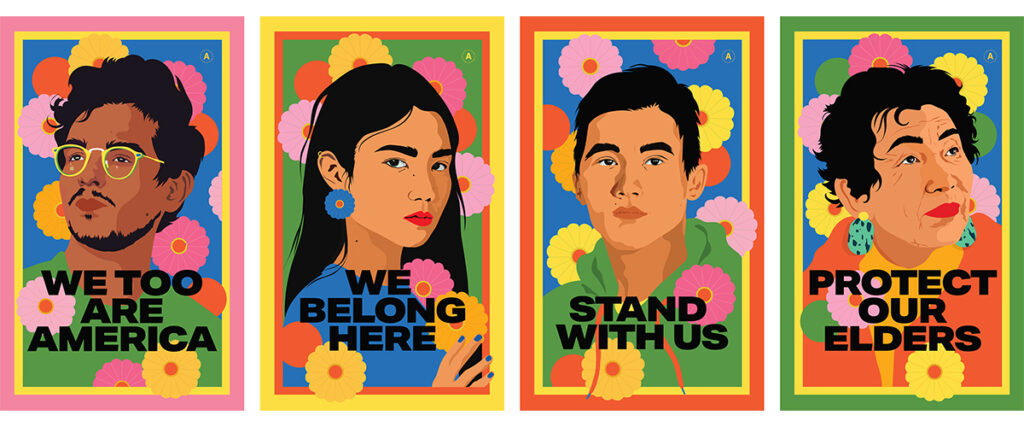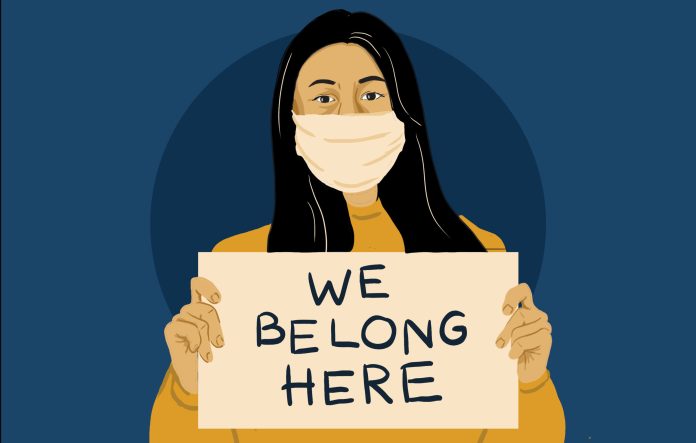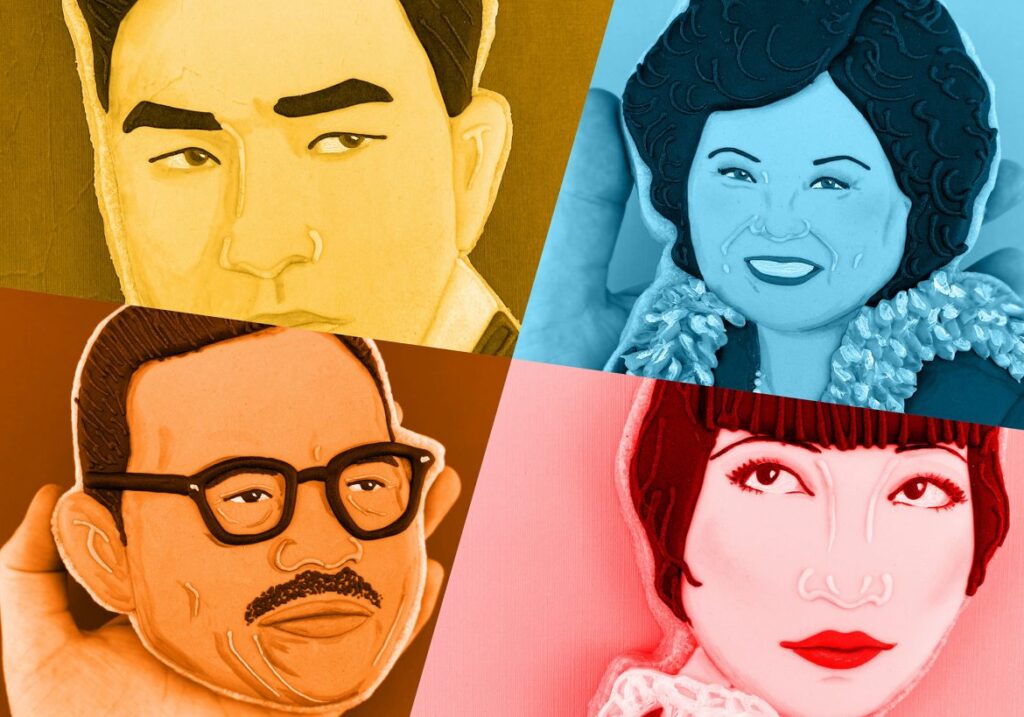During the first two weeks, we focused on gaining the necessary historical and theoretical knowledge to pursue our project exploring what it means to be Asian/American at Hamilton. Learning about the history of Asians/Asian Americans and racial formation in the United States helped us to better understand the recent rise of racially motivated hate crimes against the Asian/Asian American community not as an isolated incident, but rather as part of a series of occurrences that have been recorded and analyzed over time.
Racial Formation in the United States
For a theoretical framework, we read and discussed Racial Formation in the United States by Michael Omi and Howard Winant, which outlined the changing understandings and articulations of race throughout US history. Omi and Winant described race as being central to “the organization of political life in the United States” (3)¹. Below, we summarize the most important ideas from this text. (page numbers cited parenthetically)
From the book, we primarily focused on Parts I and II.

Part I outlined three main paradigms of race: ethnicity, class, and nation. Omi and Winant focused on these paradigms as introductory concepts; however, it is important to mention that racial formation theory critiques these models as inadequate for various reasons. Omi and Winant thus provide us with racial projects to equip us to discuss race critically. This will help to organize the discussion below.
Deviating from the understanding of race that race is purely determined by one’s biology, the ethnicity paradigm places the emphasis on cultural variables such as “attitudes and beliefs, religion, language, ‘lifestyle,’ and group identification” (22). This paradigm also emphasizes the idea that if race is primarily cultural, then assimilation can occur. Therefore, people with different cultures can bring their cultures and form a more perfect union. The ethnicity paradigm also posits the utopian notion of a colorblind society, which is defined as a society in which “racial inequality, racial politics, and race-consciousness itself would be greatly diminished in importance…” (21-22). The notion of a colorblind society, the mainstream view on how society should be viewed, furthers the idea that one can transcend race-based prejudice. Omi and Winant notice that people seem to avoid talking about race and believe that we should not study race. The question of whether critical race theory should be taught in schools is a pressing, contentious debate in the US right now. The murder of George Floyd, the 2020 Black Lives Matter protests, and the discourse surrounding the police brutality forced the nation to address the fact that racism was not solved post Civil Rights Movement and to acknowledge that a colorblind view towards race cannot solve racial tensions. With the 2021 Atlanta shooting, which was fueled by anti-Asian rhetoric, the nation could no longer continue to dismiss the country’s history of violence toward Asian/Asian Americans and the pattern of keeping those narratives invisible. People want to believe that the United States is “post-racial” and “post-civil rights” but current and aforementioned events challenge us to reconsider that notion. Additionally, Omi and Winant discuss immigration patterns in the United States, focusing on the idea of assimilation, becoming Americans, and joining the mainstream, often termed as the American ethnic pattern. Pages 37-39 discuss this idea of the American ethnic pattern, which focuses on European immigration, and is predominantly white. Immigrants are expected to come to America, learn English, adopt American mannerisms and apparel, and thus, essentially become American. The American ethnic pattern defaults to whiteness. This is believed to lead to a colorblind society and cultural pluralism. However, one of the major critiques of the ethnicity paradigm is that it neglects “stigma, exclusion, privilege, and violence, all characteristics inherent in ‘the mark of race,’ the phenomic, ‘ocular’ dimension of racial belonging” (40).
The class paradigm of race, discussed on pages 53-69, is established on a Marxist model which prioritizes the economic foundations of racial difference. It explains race as primarily a secondary effect of economic relationships: “market exchange, distribution, production.” Omi and Winant explored various models and theories relating to the class paradigm. The Market Relations Approach, discussed on pages 54-58, “deals with the social exchange of resources such as labor and credit,” and is composed of three main models: the irrational prejudice model, the monopolistic practice model, and the disruptive state interventionism model. The irrational prejudice model suggests that the market cannot stay separated on the basis of race because it is not profitable and thus will “be gradually integrated by market pressures.” The monopolistic practices model suggests that “whiteness itself is a resource” where whites have control over important resources and “competition over scarce resources motivates whites to act in exclusionary or discriminatory ways toward people of color.” The disruptive state interventionism model “accuses state policies such as minimum wage laws, labor laws, […] and importantly, affirmative action, of disrupting market equilibrium and depriving people of the opportunity to compete fairly” and encourages a laissez-faire free market approach instead. In addition to those three models, Omi and Winant discussed two theories: Stratification Theory and Class Conflict Theory. Stratification Theory, examined by Omi and Winant on pages 58-65, “deals with social distribution of resources.” Within this theory, individuals with similar resources and “roughly equal incomes” have similar chances to succeed in life. Non-economic factors play a role in constructing and maintaining the stratification throughout society where each stratification has varying degrees of social mobility. As a part of the Class Conflict Theory, discussed on pages 65-67, racial conflict occurs “within the ‘social relations of production,’ […] in terms of class conflict,” between the capitalist class (owners) and the working class. All these theories are limited by the sole focus on economics, as mentioned by Omi and Winant in the section titled “Some Critical Reflections on the Class Paradigm of Race.” In order to fully explain race, one must keep bringing in non-economic factors, like culture, and politics.
The nation based paradigm of race focuses on “the practice of ‘nation building’” specifically during the post-World War II events (75). Through pages 75-79 Omi and Winant mention how from its founding “‘the American people’ has been understood as an implicitly white designation.” From the founding days of the United States, whiteness has been central in North America and “‘anglo-conformity’ helped create a norm of whiteness that shaped the national image and culture.” With race determining citizenship, the United States, as a nation, has built its foundations ignoring the relationships race has from the start. However, when trying to think about intersectionality in the early North American nation, race, gender, and class, all three must come together. Omi and Winant, on pages 79-81, discuss the interplay of these factors: “Race shaped class in America, then, because of the demand for territorial expansion, because racial slavery was crucial to the development of the early nation, and because whiteness played an important role in deterring rebellion and undermining popular transracial solidarity.” (80). “The maintenance of ‘patriarchal authority and power, racial hierarchy, and white supremacy’” was important throughout American history (80). Thus, in the nation-based paradigm, “racial dynamics are understood as products of colonialism and therefore as outcomes of relationships which are global and epochal in character” (82). A major critique of the Nation paradigm is that it “treat[s] race as a manifestation of ‘peoplehood’” but is unable to define what “national” means, putting limitations on where they can be used (82).
Overall, none of these paradigms, i.e., ethnicity, class and nation, are enough to fully describe race. One must take aspects of all the paradigms to fully understand race. These paradigms, described by Omi and Winant, provide us with both large-scale and everyday examples of these practices (i.e. nation built on whiteness, economic perspectives, social class, etc.) which could be applied to what we know and see as race.
Omi and Winant, then present us with their understanding of race as “ a social construction and not a fixed, static category rooted in some nation of innate biological differences. It involved ‘othering,’ which is used to justify subordinate status, unequal treatment, to structure oppression and exploitation in numerous ways ” (12). By saying race is socially constructed, Omi and Winant argue that it “varies according to time and place. […] Consider Asian Americans, who have been popularly regarded as either a ‘yellow peril’ or a ‘model minority’ depending on the historical period in question, the configuration of racial hierarchy in the United States, and the prevailing tenor of United States – Asia relations” (13).

While reading Part II of the book, we primarily focused on racial projects and what they stood for. According to Omi and Winant, “a racial project is simultaneously an interpretation, representation, or explanation of racial identities and meanings, and an effort to organize and distribute resources (economic, political, cultural) along particular racial lines” (125). Racial projects occur on both the macro (i.e. collective action, racial policy-making, and state activity) and microcosms (i.e. the everyday experience) of society. An example of a larger racial project would be the passage of stricter state voting rights or collective action in regards to bettering or hurting community health of colored people. Everyday individual interactions include racial profiling by the police or joining a Black Lives Matter Movement march. Omi and Winant, on page 125, discuss racial projects mentioned as follows:
“The imposition of restrictive state voting rights laws, organizing work for immigrants’, prisoners’, and community health rights in the ghetto or barrio are all examples of racial projects. Individuals’ practices may be seen as racial projects as well: The cop who “stops and frisks” a young pedestrian, the student who joins a memorial march for the slain teenager Trayvon Martin, even the decision to wear dreadlocks, can all be understood as racial projects. Such projects should not, however, be simply regarded and analyzed as discrete, separate, and autonomous ideas and actions. Every racial project is both a reflection of and response to the broader patterning of race in the overall social system. In turn, every racial project attempts to reproduce, extend, subvert, or directly challenge that system.”
Since the concept of race is constantly evolving and changing, racial projects are always present and going on. Racial projects can often be categorized as either racist or anti-racist. A racist racial project is defined as a racial project that “creates or reproduces structures of domination based on racial significations and identities” (128). On the other hand, an anti-racist racial project resists or undoes the “structure of domination based on racial significations and identities” (129). An example of an anti-racist racial project would be organizing a movement to dismantle institutional practices of racial profiling by the police.
Our project, the website (and to a degree, our presentations), can be described as an anti-racist racial project. Through this project, we seek to inform everyone at Hamilton College about the oft-invisible, underrepresented experiences and history. In fact, our own endeavor to understand Hamilton’s Asian American history has proved difficult because of the small population size and because those experiences were not, for most of the college’s history, considered a major point of concern. Our project seeks to break the model minority stereotype and show the multi-faceted nature of being an individual that identifies as Asian and/or Asian American on campus. We want to uplift these historically marginalized voices and empower other Asians and Asian Americans to do the same. We have segmented our project into three teams to focus on history, statistics, and personal experiences. The history team seeks to understand how the nation’s major socio political events, such as the Vietnam War and 9/11, have impacted the campus and the students, especially as it pertains to its Asian/Asian American students. Our statistics team focused on collecting quantitative data that can quantify the experiences of Asian/Asian Americans on campus to better measure the level of satisfaction. Not only do we want to see the current situation at Hamilton College but also develop a sustainable model for future data collection to quantify improvements. Finally, our last team focused on gathering and reflecting on personal experiences of both project members as well as the college community. Through personal narratives and a series of interviews, we were able to describe our stories and the stories that were unheard of around campus. Not only do these stories and collection of interviews provide insight into the varying Asian and Asian American experiences across campus, but they humanize and characterize us in a way that overturns the model minority myth. Through this, people will gain insight on Asian/Asian American struggles, such as discrimination, deteriorating mental health, among many other issues that are often obscured behind popularized narratives of Asian/Asian Americans successfully achieving the “American Dream.”

Asian Americans (2020)2

For a broad overview of Asian American history, we watched the PBS series Asian Americans, which discussed “the role Asian Americans have played in shaping U.S. history, told from an Asian American perspective.” Similar to our goals with this project, the docuseries’ purpose was two-fold: “‘We want the Asian American community to feel more empowered and more engaged in American citizenship, and knowing this history is important for these new generations,’ said CAAM (Center for Asian American Media) Executive Director Stephen Gong. ‘On the other hand, clearly we believe the general public also will find great meaning in understanding our histories, the histories of our different communities.’”3 The personal narratives available on this website serve as our versions of what we saw in the docuseries.
Reflecting on this docuseries, many of us recalled not learning much Asian American history during our elementary and secondary schooling, especially as it pertained to violence against and discrimination toward Asian/Asian Americans. In order to understand our experiences in the United States, we needed to better understand Asian American history and how it continually affects us today. We presented a comprehensive summary of Asian American history as a part of the winter project report, which can be found on the homepage of our website. Below, we reflect on the most important events in Asian American history depicted in the PBS docuseries, Asian Americans (2020), and their impact on our work this summer.
This docuseries explores the influence of Asians and Asian immigration in US history through family stories passed down through generations. Through these diverse stories, the docuseries examines the legacy of legal and cultural exclusion in over a hundred years. From the Chinese Exclusion Act of 1882, unjustified denial of citizenship, portrayal in mass media, hate crimes, to the Red Scare, these stories illustrate both macro and micro experiences of Asian Americans in the United States over time. By examining these stories over time, we saw a connection between the anti-Asian sentiment that occurred throughout history to the hostile rhetoric fostered by the pandemic. Additionally, the docuseries also focused on tensions among the Asian community between various ethnicities. Through stories like the conflicted Buddy Uno, we saw the complexity between loyalty and patriarchy, and how certain aspects of stories are told, and how some are hidden. The docuseries, however, was not wholly representative in that it focused primarily on those of East Asian descent. Although the docuseries attempted to be inclusive, the representation of South Asian and Southeast Asian stories just wasn’t enough. Overall, we were all glad to gain some knowledge of Asian American history but disheartened by how long it took for us to learn it.

There are some efforts of inclusion in the media and the government that have surfaced recently. Netflix’s Never Have I Ever (2020), created by Mindy Kaling, depicting the life of an Indian-American teenager, includes a snippet informing a history class about the experiences of a man that was sent to a Japanese Internment camp, during World War II, with his family (Season 2, Episode 9 – 14:28 – 16:23).4 At the end, the man says “I need to tell my story so no one ever forgets” which is exactly why Asian American history needs to be taught to everyone, not just someone that is actively seeking it. Most recently, Illinois became the first state to require Asian American history to be taught in public schools.5 This was a moment of celebration since it was a step in the right direction but there are still many steps and many racial projects to be implemented.
1. Michael Omi, and Howard Winant. Racial Formations in the United States. New York: Routledge, 2014. Hereafter cited parenthetically by page number.
2. Asian Americans, (2020; Washington, DC: WETA and Center for Asian American Media (CAAM) for PBS, 2020), digital.
3. Momo Chang. “How the Asian Americans PBS Series Came about, and Its Key Players.” PBS, March 26, 2020. https://www.pbs.org/weta/asian-americans/how-the-asian-americans-pbs-series-came-about-and-its-key-players/.
4. Never Have I Ever, Season 2 Episode 9, “…stalked my own mother,” created by Mindy Kaling, aired 2021, on Netflix, https://www.netflix.com/watch/81302736?trackId=14277283&tctx=-97%2C-97%2C%2C%2C%2C.
5. Amy Yee. “Illinois Bets on Teaching Asian American History to Fight Racism.” Bloomberg.com. Bloomberg, July 21, 2021. https://www.bloomberg.com/news/articles/2021-07-21/illinois-becomes-first-state-to-require-asian-american-history-in-public-schools.
Bibliography
Asian Americans. 2020; Washington, DC: WETA and Center for Asian American Media (CAAM) for PBS, 2020. digital.
Chang, Momo. “How the Asian Americans PBS Series Came about, and Its Key Players.” PBS, March 26, 2020. https://www.pbs.org/weta/asian-americans/how-the-asian-americans-pbs-series-came-about-and-its-key-players/.
Kaling, Mindy, dir. Never Have I Ever, Season 2, Episode 9, “…stalked my own mother,” aired 2021, on Netflix, https://www.netflix.com/watch/81302736?trackId=14277283&tctx=-97%2C-97%2C%2C%2C%2C.
Omi, Michael, and Howard Winant. Racial Formations in the United States. New York: Routledge, 2014.
Yee, Amy. “Illinois Bets on Teaching Asian American History to Fight Racism.” Bloomberg.com. Bloomberg, July 21, 2021. https://www.bloomberg.com/news/articles/2021-07-21/illinois-becomes-first-state-to-require-asian-american-history-in-public-schools.
